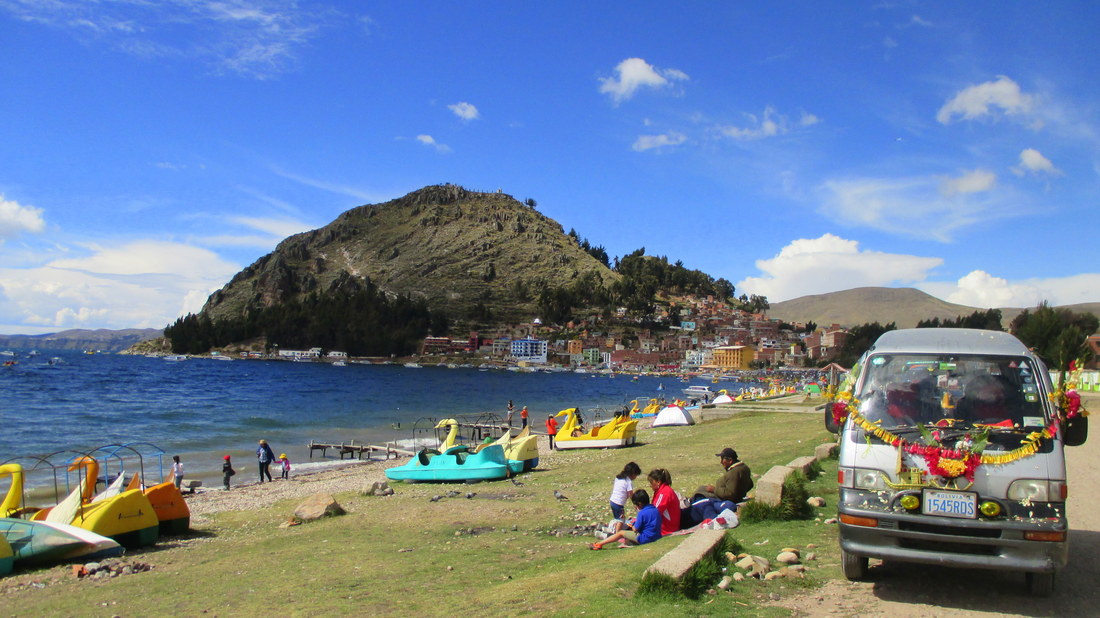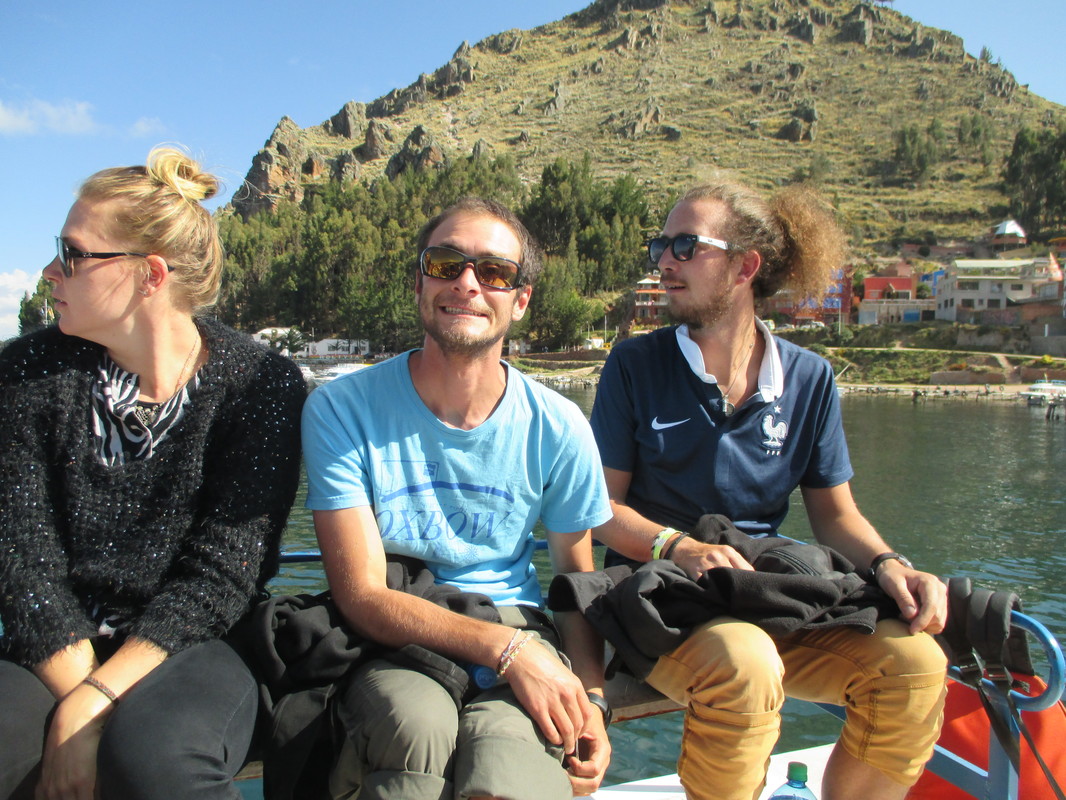Copacabana / Isla del Sol
For budget tips & compact place-specific travel info... Download my FREE Budget Fact Sheets. You're welcome.
| Download Steph's COPACABANA Quick Budget Fact Sheet | |
| File Size: | 651 kb |
| File Type: | |
Copacabana was on the way to Peru, so I could give it a try. That's what many travelers think I guess, as this place is absolutely loaded with sunburnt white people. Why? No idea, as there’s nothing there except of an impressive amount of (cheap!) hostels, travel agencies, tourist shops and tourist-only restaurants.
I decided to take the local bus from La Paz, as I’d rather be surrounded with locals than with the Copacabana target group. That wasn’t a great idea, as I had to dive into the aggressive chaos of Bolivian travelers and had to wait 2 hours squeezed by people holding up their money in their fists in order to be the first to get a seat. At some point I managed to get a ticket though, and made instant friends with 2 French guys from my previous hostel by buying some for them too.
In Bolivia I spoke more French than Spanish, English, my mother tongue or any other language anyway… this country is absolutely invaded by these often beautiful, kind of cocky only-French-speaking baguette-eaters.
In Bolivia I spoke more French than Spanish, English, my mother tongue or any other language anyway… this country is absolutely invaded by these often beautiful, kind of cocky only-French-speaking baguette-eaters.
When Benjamin, Vincent and I arrived we took the furthest located hostel for no other reason than that we were both indecisive and a bit screwed up in the head. Or maybe our instinct forced us out of the tourist-invaded town filled up with lama-gloves and plastic inca-rubbish.
Our 25-bolivianos (€3) colorful hostel, which had no warm water and where we had to flush our turds with a bucket of water, guaranteed beautiful views of the harbour and the house-dotted mountains of Copacabana.
Our 25-bolivianos (€3) colorful hostel, which had no warm water and where we had to flush our turds with a bucket of water, guaranteed beautiful views of the harbour and the house-dotted mountains of Copacabana.
Because picturesque it is, you gotta give ‘em credits for that. After last night’s Halloween party in the rowdy Wild Rover hostel I decided to go for a quiet night. Usually when I decide such things fate intends to play games with me. This night was no exception. Although Copa has no nightlife at all, we managed to find the only half-empty local bar there was and started ordering tasteless Bolivian wine until closure time. On the rocky ‘beach’ we caught up with some lads from La Paz and some other gringo’s, and partied until the sun came up at 7AM. I have to defend myself here: I didn’t only party, I developed my languages significantly by constantly switching to conversations in English, French, Austrian German and Spanish at a fast pace. Although your skin almost burns off during the day, at night the temperatures can drop below zero: very Bolivian. Luckily that’s no issue if you’re a blue-eyed Holandesa, as in exchange for many Facebook-selfies I got offered a wide arrange of jackets and sweaters.
The second day can’t be described as very productive, as you can imagine. We had breakfast at 4PM while my companions devoured some fresh-caught trucha (trout), the local specialty. We strolled to the bright white cathedral and saw a guy in a dress with a bucket signed with a cross throwing water over cars with a toilet brush. Apparently it’s normal here to baptize your car before you hit the road: Benediciones de movilidades. Whatever makes them happy.
The next day we had bigger plans: Isla del Sol was on the agenda. According to Inca legend the sun was created on this island.
The sun never left I guess, as it was absolutely skin-blistering hot. Neither factor 30 sunscreen nor my Ali-Baba-look (Arafat-scarf knotted around my head) could prevent me from slowly turning into a sweaty lobster. I didn’t care though, as this place was absolutely stunning. We walked from the northern Challapampa to the southern Ymani and passed deserted beaches, traditional tribal villages and were rewarded with constant overwhelming panoramas.
The sun never left I guess, as it was absolutely skin-blistering hot. Neither factor 30 sunscreen nor my Ali-Baba-look (Arafat-scarf knotted around my head) could prevent me from slowly turning into a sweaty lobster. I didn’t care though, as this place was absolutely stunning. We walked from the northern Challapampa to the southern Ymani and passed deserted beaches, traditional tribal villages and were rewarded with constant overwhelming panoramas.
We did take the effort to search for the Escalinata del Inca and the Temple of the Sun, but that wasn’t really worth the effort: The island itself is a world class attraction. Off course, the inhabitants know that, and therefore we had to pay ‘entrance’ twice for just walking around. We spent the night in Ymani in a hotel with a view, but no warm water… oh wait, no water at all. I still love you, my sweet Bolivia, so I will forgive you this time.
We had the plan to visit the less touristy Valle de la Luna the day after, as the views were supposed to be as amazing. However, for views you need eyes. And my eyes were temporarily out of order, as I lost a contact lens. I never lose my lenses, but when I do I off course do it when I only brought a daypack without back-up lenses or glasses. So while bumping into the tiny cholita women and lama’s I stumbled my way back to the boat to Copacabana, where I luckily couldn’t see the mass tourism anymore.
We had the plan to visit the less touristy Valle de la Luna the day after, as the views were supposed to be as amazing. However, for views you need eyes. And my eyes were temporarily out of order, as I lost a contact lens. I never lose my lenses, but when I do I off course do it when I only brought a daypack without back-up lenses or glasses. So while bumping into the tiny cholita women and lama’s I stumbled my way back to the boat to Copacabana, where I luckily couldn’t see the mass tourism anymore.
In order to support the travelers’ community, I spend many hours per week to adequately document all information and advices for prospective visitors, accompanied by a (hopefully) entertaining insight into my personal observations and experiences. This service is and will remain free. However, if you voluntarily want to make a contribution and support my travels and thus the creation of new stories and information supply, here is the button you’re looking for:
Related:
- Go to the Bolivia Page for more blogs and hiking adventures!
- Check out Budget Bucket List's FAVORITE HIKING DESTINATIONS worldwide!
- Just across the border: Puno, Peru. Go here for Puno Day!
- Mountainbiking the Death Road in Bolivia
- Outdoor lover? Head down to Ecuador and don't miss Banos
- Back to Inca heritage: Machu Picchu, Peru
- Inca museums in Arequipa, Peru
- Inca aqueducts around Cajamarca, Peru
- The MAAM Museum in Salta, Argentina and its Inca children
- The city of Maya ruins: San Ignacio, Belize
- City of Mayas: Tikal, Guatemala
- Visit the Maya Ruins in Copán, Honduras
- Maya and Aztec heritage in Mexico: Merida, Izamal, Tulum, Palenque, Oaxaca, Valladolid and Mexico City
- New Zealand's most famous coastal national park: Abel Tasman NP
- Go to the Bolivia Page for more blogs and hiking adventures!
- Check out Budget Bucket List's FAVORITE HIKING DESTINATIONS worldwide!
- Just across the border: Puno, Peru. Go here for Puno Day!
- Mountainbiking the Death Road in Bolivia
- Outdoor lover? Head down to Ecuador and don't miss Banos
- Back to Inca heritage: Machu Picchu, Peru
- Inca museums in Arequipa, Peru
- Inca aqueducts around Cajamarca, Peru
- The MAAM Museum in Salta, Argentina and its Inca children
- The city of Maya ruins: San Ignacio, Belize
- City of Mayas: Tikal, Guatemala
- Visit the Maya Ruins in Copán, Honduras
- Maya and Aztec heritage in Mexico: Merida, Izamal, Tulum, Palenque, Oaxaca, Valladolid and Mexico City
- New Zealand's most famous coastal national park: Abel Tasman NP





